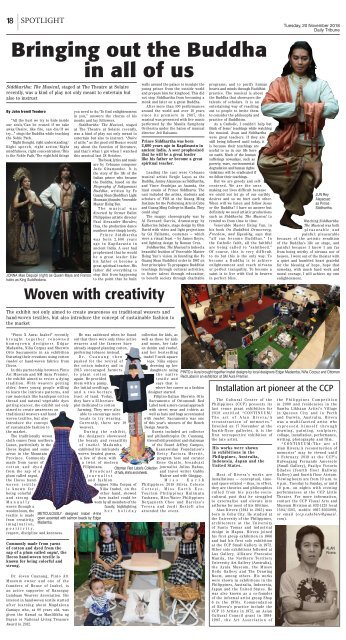20 NOVEMBER 2018
Create successful ePaper yourself
Turn your PDF publications into a flip-book with our unique Google optimized e-Paper software.
18<br />
SPOTLIGHT<br />
Tuesday, <strong>20</strong> November <strong>20</strong>18<br />
Daily Tribune<br />
Bringing out the Buddha<br />
in all of us<br />
Siddhartha: The Musical, staged at The Theatre at Solaire<br />
recently, was a kind of play not only meant to entertain but<br />
also to instruct<br />
By John Iremil Teodoro<br />
“All the hurt we try to hide inside<br />
our souls/Can be erased if we take<br />
away/Desire, like fire, can die/If we<br />
try…” sings the Buddha while teaching<br />
the Noble Path.<br />
“Right thought, right understanding/<br />
Right speech, right action/Right<br />
mindfulness, right concentration/This<br />
is the Noble Path/The eightfold things<br />
JONNA Mae Daquipil (right) as Queen Maya and Francis<br />
Isidro as King Suddhodana.<br />
you need to do/To find enlightenment<br />
in you,” answers the chorus of his<br />
monks and lay followers.<br />
Siddhartha: The Musical, staged<br />
at The Theatre at Solaire recently,<br />
was a kind of play not only meant to<br />
entertain but also to instruct. “Dulce<br />
et utile,” as the good old Horace would<br />
say about the function of literature,<br />
and that’s what I got when I watched<br />
this musical last 28 October.<br />
The book, lyrics and music<br />
are by Cebuano composer<br />
Jude Gitamondoc. It is<br />
the story of the life of the<br />
Indian prince who became<br />
the Buddha, based on the<br />
Biography of Sakyamuni<br />
Buddha, written by Fo<br />
Guang Shan (Buddha’s Light<br />
Mountain) founder, Venerable<br />
Master Hsing Yun.<br />
The musical was<br />
directed by former Ballet<br />
Philippines artistic director<br />
Paul Alexander Morales;<br />
thus, the production dance<br />
numbers were simply lovely.<br />
Prince Siddhartha<br />
was born 2,600 years<br />
ago in Kapilavastu in<br />
ancient India. A seer had<br />
prophesized that he would<br />
be a great leader like<br />
his father or become a<br />
great spiritual teacher. His<br />
father did everything to<br />
stop this from happening<br />
to the point that he built<br />
Woven with creativity<br />
walls around the palace to insulate the<br />
young prince from the outside world<br />
and prepare him for kinghood. This did<br />
not stop Siddhartha from becoming a<br />
monk and later on a great Buddha.<br />
After more than 100 performances<br />
around the world and over 10 years<br />
since its premiere in <strong>20</strong>07, the<br />
musical was presented with live music<br />
performed by the Manila Symphony<br />
Orchestra under the baton of musical<br />
director Jed Balsamo.<br />
Prince Siddhartha was born<br />
2,600 years ago in Kapilavastu in<br />
ancient India. A seer prophesized<br />
that he will be a great leader<br />
like his father or become a great<br />
spiritual teacher.<br />
Leading the cast were Cebuano<br />
musical artists Benjie Layos as the<br />
Buddha, Junrey Alayacyac as Siddhartha,<br />
and Vince Sendrijas as Ananda, the<br />
loyal cousin of Prince Siddharta. The<br />
cast included the artists, students and<br />
scholars of FGS at the Guang Ming<br />
Institute for the Performing Arts in Cebu<br />
and Guang Ming College in Manila. They<br />
could sing!<br />
The snappy choreography was by<br />
Al Bernard Garcia, dramaturgy by<br />
Katherine Sabate, stage design by Ohm<br />
David with video and light projections<br />
by GA Fallarme, costumes — which<br />
were a visual feast — by James Reyes,<br />
and lighting design by Roman Cruz.<br />
Siddhartha: The Musical is indeed a<br />
beautiful fruition of Venerable Master<br />
Hsing Yun’s vision in founding the Fo<br />
Guang Shan Buddhist order in 1967 on<br />
four principles: To propagate Buddhist<br />
teachings through cultural activities;<br />
to foster talent through education;<br />
to benefit society through charitable<br />
The exhibit not only aimed to create awareness on traditional weavers and<br />
hand-woven textiles, but also introduce the concept of sustainable fashion to<br />
the market<br />
programs; and to purify human<br />
hearts and minds through Buddhist<br />
practice. The musical is about<br />
the Buddha that showcases the<br />
talents of scholars. It is an<br />
entertaining way of reaching<br />
out to people to invite them<br />
to consider the philosophy and<br />
practice of Buddhism.<br />
As a Catholic, I couldn’t help but<br />
think of Jesus’ teachings while watching<br />
the musical. Jesus and Siddhartha<br />
were great teachers. If they are<br />
still being followed until today, it<br />
is because their teachings are<br />
useful to us in our life here<br />
on earth. Much of the human<br />
sufferings nowadays, such as<br />
poverty, wars, environmental<br />
degradation and human rights<br />
violations will be eradicated if<br />
we follow their teachings.<br />
But we are greedy and selfcentered.<br />
We are the ones<br />
making our lives difficult because<br />
we could not let go of our earthly<br />
desires and so we hurt each other.<br />
When will we listen and follow Jesus<br />
or the Buddha? I have no answer but<br />
definitely we need artistic productions<br />
such as Siddharta: The Musical to<br />
remind us from time to time.<br />
Venerable Master Hsing Yun, in<br />
his book On Buddhist Democracy,<br />
Freedom, and Equality, says that<br />
“all can become Buddhas.” In<br />
the Catholic faith, all the faithful<br />
are being called to “sainthood.”<br />
Of course, this is very difficult<br />
to do but this is the only way. To<br />
become a Buddha is to achieve<br />
enlightenment and reach nirvana<br />
or perfect tranquility. To become a<br />
saint is to live with God in heaven<br />
in perfect bliss.<br />
JUN Rey<br />
Alayacyac<br />
as Prince<br />
Siddhartha.<br />
Watching Siddhartha:<br />
The Musical was both<br />
pleasurable and<br />
painful: pleasurable<br />
because of the artistic rendition<br />
of the Buddha’s life on stage, and<br />
painful because I know I am far<br />
from being worthy of nirvana nor of<br />
heaven. I went out of the theater with<br />
a quiet and humbled heart grateful<br />
for the blessing of hope, hope that<br />
someday, with much hard work and<br />
moral courage, I will achieve my own<br />
enlightenment.<br />
“Pinto X Aura: Inabel” recently<br />
brought together renowned<br />
homegrown designers Edgar<br />
Madamba, Niña Corpuz and Sherwin<br />
Otto Sacramento in an exhibition<br />
featuring their creations using cotton<br />
inabel or hand-woven fabrics from<br />
Ilocos.<br />
In this partnership between Pinto<br />
Art Museum and SM Aura Premier,<br />
the exhibit aimed to revive a dying<br />
tradition. With weavers getting<br />
older, fewer young people willing<br />
to learn the intricate patterns, and<br />
raw materials like handspun cotton<br />
thread and natural vegetable dyes<br />
getting scarcer, the exhibit not only<br />
aimed to create awareness on<br />
traditional weavers and handwoven<br />
textiles, but also<br />
introduce the concept<br />
of sustainable fashion to<br />
the market.<br />
The traditionally woven<br />
cloth comes from northern<br />
Luzon, particularly in the<br />
Ilocos Region and some<br />
areas in the Mountain<br />
Province. Commonly<br />
made from yarns of<br />
cotton and dyed<br />
from the sap of a<br />
plum called sagut,<br />
the Ilocos handwoven<br />
textile<br />
is known for<br />
being colorful<br />
and strong.<br />
Manually<br />
woven through a<br />
wooden loom, the<br />
textile is made<br />
from creativity,<br />
imagination,<br />
positivity,<br />
respect, discipline and keenness.<br />
Commonly made from yarns<br />
of cotton and dyed from the<br />
sap of a plum called sagut, the<br />
Ilocos hand-woven textile is<br />
known for being colorful and<br />
strong.<br />
METICULOUSLY designed Inabel A-line<br />
gown accented with salmon beads by Edgar<br />
Madamba.<br />
Dr. Joven Cuanang, Pinto Art<br />
Museum owner and one of the<br />
founders of House of Inabel, is<br />
an active supporter of Barangay<br />
Lumbaan Weavers Association. His<br />
interest in hand-woven textile started<br />
after learning about Magdalena<br />
Gamayo who, at 88 years old, was<br />
given the Gawad sa Manlilikha ng<br />
Bayan or National Living Treasure<br />
Award in <strong>20</strong>12.<br />
He was saddened when he found<br />
out that there were only three active<br />
weavers and the farmers have<br />
already stopped planting cotton,<br />
preferring tobacco instead.<br />
Dr. Cuanang then<br />
pushed for the revival of<br />
the cotton industry and in<br />
<strong>20</strong>15 encouraged farmers<br />
to plant cotton<br />
again. He provided<br />
them with a pump,<br />
the initial seedlings<br />
and a two-hectare<br />
tract of land. Today,<br />
they have a 22-hectare<br />
plot dedicated to cotton<br />
farming. They were also<br />
able to encourage more<br />
locals to try weaving.<br />
Currently, there are 18<br />
weavers.<br />
During the exhibit,<br />
the designers showcased<br />
the beauty and versatility<br />
of inabel. Madamba<br />
exhibited his intricately<br />
woven beaded gowns,<br />
a few of them with<br />
a twist of modern<br />
Filipiniana.<br />
Broadcast<br />
journalist<br />
and fashion<br />
designer Niña Corpuz of<br />
Niña Inabel, on the<br />
other hand, showed<br />
how inabel could be<br />
worn by all members of the<br />
Ottoman Red Label’s Collection<br />
of hats, shirts and sheets.<br />
family, highlighting<br />
her holiday<br />
collection for kids, as<br />
well as those for kids<br />
and moms, her take<br />
on denim and inabel,<br />
and her bestselling<br />
inabel V-neck square<br />
tops. Niña enjoys<br />
dressing up her<br />
daughters using<br />
the native<br />
textile and<br />
says that is<br />
where her career as a fashion<br />
designer started.<br />
Filipino-Italian Sherwin Otto<br />
Sacramento of Ottomondi Red<br />
Label took a more casual approach<br />
with street wear and t-shirts as<br />
well as hats and bags accentuated<br />
with inabel. Sacramento was one<br />
of this year’s winners of the Bench<br />
Design Awards.<br />
Guests included art collector<br />
and philanthropist Dr. Cuanang,<br />
Greenfield president and chairman<br />
of the Board Jeffrey Campos,<br />
Kannawidan Foundation’s<br />
Betty Factora Merritt,<br />
program host and curator<br />
Rene Guatlo, broadcast<br />
journalist Julius Babao,<br />
and travel writer Gabby<br />
Malvar and wife Ginggay.<br />
M i s s E a r t h<br />
Philippines <strong>20</strong>18 Silvia Celeste<br />
Cortesi, Miss Earth Eco-<br />
Tourism Philippines Halimatu<br />
Yushawu, Miss Water Philippines<br />
Berjayneth Chee and Barcino’s<br />
Teresa and Jordi Rostoll also<br />
attended the event.<br />
NIÑA Corpuz’s daughters Stella and<br />
Emily with their baby brother Lucas<br />
wearing clothes from their mom’s<br />
Inabel collection.<br />
PINTO x Aura brought together inabel designs by local designers Edgar Madamba, Niña Corpuz and Ottoman<br />
Red Label in an exhibition at SM Aura Premier.<br />
Installation art pioneer at the CCP<br />
The Cultural Center of the<br />
Philippines (CCP) presents its<br />
last venue grant exhibition for<br />
<strong>20</strong>18 entitled “CONTINUUM/<br />
The art of Alan Rivera/A<br />
reconstruction of memories.”<br />
Unveiled on 17 November at the<br />
fourth-floor galleries, it is the<br />
first retrospective exhibition of<br />
the late artist.<br />
His works were shown<br />
in exhibitions in the<br />
Philippines, Australia,<br />
Indonesia, Japan and the<br />
United States.<br />
Most of Rivera’s works are<br />
installations — conceptual, timeand<br />
space-related — thus, in effect,<br />
they are theories and philosophies<br />
culled from his psycho-sociocultural<br />
past that he struggled<br />
to externalize and elevate into<br />
artforms for most of his lifetime.<br />
Alan Rivera (1941 to <strong>20</strong>15) was<br />
born in Cebu City. He studied at<br />
the University of the Philippines,<br />
architecture at the University<br />
of Santo Tomas and industrial<br />
design in Mapua. Rivera joined<br />
his first group exhibition in 1966<br />
and had his first solo exhibition<br />
at the CCP Small Gallery in 1972.<br />
Other solo exhibitions followed at<br />
Luz Gallery, Alliance Francaise<br />
Manila, the Northern Territory<br />
University Art Gallery (Australia),<br />
the Ayala Museum, the Museo<br />
Iloilo Gallery and The Drawing<br />
Room, among others. His works<br />
were shown in exhibitions in the<br />
Philippines, Australia, Indonesia,<br />
Japan and the United States. He<br />
was also known as a co-founder<br />
of the informal artist group Shop<br />
6 in the 1970s. Commendation<br />
of Rivera’s practice include the<br />
CCP 13 Artists in 1972, an Asian<br />
Cultural Council grant in 1994-<br />
1995, the Art Association of<br />
the Philippines Competition<br />
in <strong>20</strong>00 and residencies in the<br />
Samba Likhaan Artist’s Village<br />
in Quezon City and in Perth<br />
and Darwin, Australia. Rivera<br />
was a multi-faceted artist who<br />
expressed himself through<br />
drawing, painting, sculpture,<br />
collage, installation, performance,<br />
writing, photography and film.<br />
“CONTINUUM/The art of<br />
Alan Rivera/A reconstruction of<br />
memories” may be viewed until<br />
3 February <strong>20</strong>19 at the CCP’s<br />
Bulwagang Fernando Amorsolo<br />
(Small Gallery), Pasilyo Victorio<br />
Edades (fourth floor Hallway<br />
Gallery) and fourth floor Atrium.<br />
Viewing hours are from 10 a.m. to<br />
6 p.m., Tuesday to Sunday, or until<br />
10 p.m. on nights with evening<br />
performances at the CCP Little<br />
Theater. For more information,<br />
contact the CCP Visual Arts and<br />
Museum Division at 832-1125 local<br />
1504/1505, mobile 0917-6033809,<br />
or email (ccp.exhibits@gmail.<br />
com).<br />
ALAN<br />
Rivera.


















